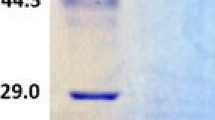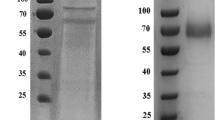Abstract
A novel laccase gene from Monilinia fructigena was synthesized chemically according to the yeast bias codon and integrated into the genome of Pichia pastoris GS115 by electroporation. The expressed enzyme was recovered from the culture supernatant and purified. The result of enzyme activity assay and SDS-PAGE demonstrated that the recombinant laccase was induced and extracellularly expressed in P. pastoris. Main biochemical properties of this laccase, such as thermodependence and thermostability, optimal pH and pH stability, and the effect of metal ions and inhibitors, were characterized. With 2,2′-azinobis-(3-ethylbenzothiazoline-6-sulfonate (ABTS) as the substrate, MfLcc had its optimal pH at 3.5 and optimal temperature at 45°C. The Km values of the ABTS, guaiacol were 0.012 and 0.016 Mm, respectively, and the corresponding V max values are 243.9 and 10.55 Um min−1 mg−1, respectively. The recombinant laccase degraded 80% 2,4,6-trichlorophenol after 8 h under the optimal conditions. The recombinant strain and its laccase can be considered as candidate for treating waste water polluted with trichlorophenols.





Similar content being viewed by others
Reference
Messerschmidt A, Huber R (1990) The blue oxidases, ascorbate oxidase, laccase and ceruloplasmin. Modelling and structural relationships. Eur J Biochem 187(2):341–352
Thurston CF (1994) The structure and function of fungal laccases. Microbiology 140:12–26
Yinghui D, Qiuling W, Shiyu F (2002) Laccase stabilization by covalent binding immobilization on activated polyvinyl alcohol carrier. Lett Appl Microbiol 35(6):451–456
Jonsson LJ, Saloheimo M, Penttila M (1997) Laccase from the white-rot fungus Trametes versicolor: cDNA cloning of lcc1 and expression in Pichia pastoris. Curr Genet 32(6):425–430
Hirschhauser S, Frohlich J (2007) Multiplex PCR for species discrimination of Sclerotiniaceae by novel laccase introns. Int J Food Microbiol 118(2):151–157
Hong Y, Xiao Y, Zhou H, Fang W, Zhang M, Wang J, Wu L, Yu Z (2006) Expression of a laccase cDNA from Trametes sp. AH28–2 in Pichia pastoris and mutagenesis of transformants by nitrogen ion implantation. FEMS Microbiol Lett 258(1):96–101
Liu W, Chao Y, Liu S, Bao H, Qian S (2003) Molecular cloning and characterization of a laccase gene from the basidiomycete Fome lignosus and expression in Pichia pastoris. Appl Microbiol Biotechnol 63(2):174–181
Huang SJ, Liu ZM, Huang XL, Guo LQ, Lin JF (2011) Molecular cloning and characterization of a novel laccase gene from a white-rot fungus Polyporus grammocephalus TR16 and expression in Pichia pastoris. Lett Appl Microbiol 52(3):290–7. doi:10.1111/j.1472-765X.2011.02997.x
Leontievsky AA, Myasoedova NM, Baskunov BP, Golovleva LA, Bucke C, Evans CS (2001) Transformation of 2,4,6-trichlorophenol by free and immobilized fungal laccase. Appl Microbiol Biotechnol 57(1–2):85–91
Xiong AS, Yao QH, Peng RH, Li X, Fan HQ, Cheng ZM, Li Y (2004) A simple, rapid, high-fidelity and cost-effective PCR-based two-step DNA synthesis method for long gene sequences. Nucleic Acids Res 32(12):e98
Wang ZD, Wang BJ, Ge YD, Pan W, Wang J, Xu L, Liu AM, Zhu GP (2011) Expression and identification of a thermostable malate dehydrogenase from multicellular prokaryote Streptomyces avermitilis MA-4680. Mol Biol Rep 38(3):1629–1636
Fan JX, Yang Q, Liu ZH, Huang XM, Song JZ, Chen ZX, Sun Y, Liang Q, Wang S (2011) The characterization of transaldolase gene tal from Pichia stipitis and its heterologous expression in Fusarium oxysporum. Mol Biol Rep 38(3):1831–1840. doi:10.1007/s11033-010-0299-4
Song J, Zhou C, Liu R, Wu X, Wu D, Hu X, Ding Y (2010) Expression and purification of recombinant arginine decarboxylase (speA) from Escherichia coli. Mol Biol Rep 37(4):1823–1829. doi:10.1007/s11033-009-9617-0
Liu ZH, Wang YC, Qi XT, Yang CP (2009) Cloning and characterization of a chitinase gene Lbchi31 from Limonium bicolor and identification of its biological activity. Mol Biol Rep 37(5):2447–2453. doi:10.1007/s11033-009-9756-3
Afzal S, Saleem M, Yasmin R, Naz M, Imran M (2010) Pre and post cloning characterization of a beta-1,4-endoglucanase from Bacillus sp. Mol Biol Rep 37(4):1717–1723. doi:10.1007/s11033-009-9592-5
Du QL, Cui WZ, Zhang CH, Yu DY (2010) GmRFP1 encodes a previously unknown RING-type E3 ubiquitin ligase in soybean (Glycine max). Mol Biol Rep 37(2):685–693. doi:10.1007/s11033-009-9535-1
Song J, Liu B, Liu Z, Yang Q (2010) Cloning of two cellobiohydrolase genes from Trichoderma viride and heterogeneous expression in yeast Saccharomyces cerevisiae. Mol Biol Rep 37(4):2135–2140. doi:10.1007/s11033-009-9683-3
Dedeyan B, Klonowska A, Tagger S, Tron T, Iacazio G, Gil G, Le Petit J (2000) Biochemical and molecular characterization of a laccase from Marasmius quercophilus. Appl Environ Microbiol 66(3):925–929
Pegasova TV, Zwart P, Koroleva OV, Stepanova EV, Rebrikov DV, Lamzin VS (2003) Crystallization and preliminary X-ray analysis of a four-copper laccase from Coriolus hirsutus. Acta Crystallogr D Biol Crystallogr 59(Pt 8):1459–1461
Hilden K, Hakala TK, Lundell T (2009) Thermotolerant and thermostable laccases. Biotechnol Lett 31(8):1117–1128
Dong JL, Zhang YZ (2004) Purification and characterization of two laccase isoenzymes from a ligninolytic fungus Trametes gallica. Prep Biochem Biotechnol 34(2):179–194
Dantan-Gonzalez E, Vite-Vallejo O, Martinez-Anaya C, Mendez-Sanchez M, Gonzalez MC, Palomares LA, Folch-Mallol J (2008) Production of two novel laccase isoforms by a thermotolerant strain of Pycnoporus sanguineus isolated from an oil-polluted tropical habitat. Int Microbiol 11(3):163–169
Gaitan IJ, Medina SC, Gonzalez JC, Rodriguez A, Espejo AJ, Osma JF, Sarria V, Almeciga-Diaz CJ, Sanchez OF (2011) Evaluation of toxicity and degradation of a chlorophenol mixture by the laccase produced by Trametes pubescens. Bioresour Technol 102(3):3632–3635
Acknowledgment
This research study was supported with funding from the Science and Technology Commission of Shanghai Municipality (09dz2200800).
Author information
Authors and Affiliations
Corresponding author
Electronic supplementary material
Below is the link to the electronic supplementary material.
Rights and permissions
About this article
Cite this article
Bao, W., Peng, R., Zhang, Z. et al. Expression, characterization and 2,4,6-trichlorophenol degradation of laccase from Monilinia fructigena . Mol Biol Rep 39, 3871–3877 (2012). https://doi.org/10.1007/s11033-011-1166-7
Received:
Accepted:
Published:
Issue Date:
DOI: https://doi.org/10.1007/s11033-011-1166-7




